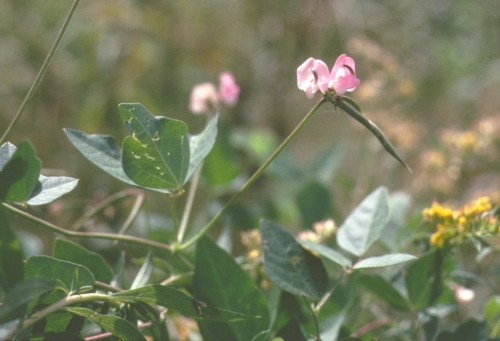Plants and Animals
Strophostyles helvula Trailing wild bean
Key Characteristics
Low, twining to trailing annual vine (up to 1 m) of open, moist, sandy soil; alternate trifoliate leaves sparsely hairy beneath, the leaflets often with a coarse lobe on one side; producing peduncles from leaf axils that are few-flowered, bearing pinkish, pea-like flowers and greenish pods that are coiled after seed dispersal.
Status and Rank
US Status: No Status/Not Listed
State Status: SC - Special Concern (rare or uncertain; not legally protected)
Global Rank: G5 - Secure
State Rank: S3 - Vulnerable
Occurrences
| County | Number of Occurrences | Year Last Observed |
|---|---|---|
| Allegan | 1 | 2002 |
| Berrien | 5 | 1981 |
| Kent | 1 | 1979 |
| Monroe | 12 | 2024 |
| Muskegon | 1 | 1961 |
| Ottawa | 1 | 1918 |
| Van Buren | 1 | 1880 |
| Washtenaw | 1 | 1924 |
| Wayne | 4 | 2014 |
Information is summarized from MNFI's database of rare species and community occurrences. Data may not reflect true distribution since much of the state has not been thoroughly surveyed.
Habitat
Trailing wild bean is found in sandy soil, thickets on disturbed ground, roadsides, ditch banks, beaches, and dunes.
Natural Community Types
- Coastal plain marsh
- Emergent marsh
- Great lakes marsh
- Interdunal wetland
- Lakeplain wet prairie
- Lakeplain wet-mesic prairie
- Mesic sand prairie
- Sand and gravel beach
- Southern shrub-carr
- Southern wet meadow
- Wet prairie
- Wet-mesic prairie
- Wet-mesic sand prairie
For each species, lists of natural communities were derived from review of the nearly 6,500 element occurrences in the MNFI database, in addition to herbarium label data for some taxa. In most cases, at least one specimen record exists for each listed natural community. For certain taxa, especially poorly collected or extirpated species of prairie and savanna habitats, natural community lists were derived from inferences from collection sites and habitat preferences in immediately adjacent states (particularly Indiana and Illinois). Natural communities are not listed for those species documented only from altered or ruderal habitats in Michigan, especially for taxa that occur in a variety of habitats outside of the state.
Natural communities are not listed in order of frequency of occurrence, but are rather derived from the full set of natural communities, organized by Ecological Group. In many cases, the general habitat descriptions should provide greater clarity and direction to the surveyor. In future versions of the Rare Species Explorer, we hope to incorporate natural community fidelity ranks for each taxon.
Associated Plants
Water-plantain, sedges, spike-rush, northern manna grass, cut grass, smartweed, arrowhead, bur-reed, cat-tail, wild rice, water-milfoil, watercress, great duckweed, water-lily, bulrush, pickerel weed, arrow-arum, pondweed, little bluestem, big bluestem, colic root, wild indigo, common horsetail, path rush, hairy pinweed, pale spiked lobelia, mountain mint, meadowsweet, tall goldenrod, bulrush.
Management Recommendations
To preserve this species, protect habitat and maintain wetland hydrology and natural cycle of fluctuations in emergent marsh. Agricultural run-off has negative impacts. Protect habitat from development.
Survey Methods
Random meander search covers areas that appear likely to have rare taxa, based on habitat and the judgment of the investigator.
-
Meander search
-
Survey Period: From fourth week of July to fourth week of September
-
References
Survey References
- Elzinga, C.L., D.W. Salzer, and J.W. Willoughby. 1998. Measuring and Monitoring Plant Populations. The Nature Conservancy and Bureau of Land Management, Denver. BLM Technical Reference 1730-1. 477pp.
- Goff, G.F., G.A. Dawson, and J.J. Rochow. 1982. Site examination for Threatened and Endangered plant species. Environmental Management 6(4): 307-316
- Nelson, J.R. 1984. Rare Plant Field Survey Guidelines. In: J.P. Smith and R. York. Inventory of rare and endangered vascular plants of California. 3rd Ed. California Native Plant Society, Berkeley. 174pp.
- Nelson, J.R. 1986. Rare Plant Surveys: Techniques For Impact Assessment. Natural Areas Journal 5(3):18-30.
- Nelson, J.R. 1987. Rare Plant Surveys: Techniques for Impact Assessment. In: Conservation and management of rare and endangered plants. Ed. T.S. Elias. California Native Plant Society, Sacramento. 8pp.
Technical References
- Deam, C. C. 1940. Flora of Indiana. Department of Conservation, Indianapolis. 1236pp.
- Gleason, H. A., and A. Cronquist. 1991. Manual of Vascular Plants of Northeastern United States and Adjacent Canada. 2nd Ed. The New York Botanical Garden, New York, New York.
- Gray, A. 1950. Gray's Manual of Botany; eighth ed. Van Nostrand Reinghold, New York. 1632pp.
- Holmgren, N.H. 1998. Illustrated Companion to Gleason and Cronquist's Manual. Illustrations of the vascular plants of Northeastern United States and adjacent Canada. New York Botanical Garden, Bronx. 937pp.
- Mohlenbrock, R.H. 1986. Guide to the Vascular Flora of Illinois. Southern Illinois University Press, Carbondale. 507pp.
- Swink, F. and G. Wilhelm. 1994. Plants of the Chicago Region, 4th ed. Indiana Academy of Science, Indianapolis. 921pp.
- Voss, E. G. 1985. Michigan Flora. Part II. Dicots (Saururaceae-Cornaceae). Bulletin of the Cranbrook Institute of Science and University of Michigan Herbarium. 724pp.


